Tags
Related Posts
Share This
Volunteering for Animals
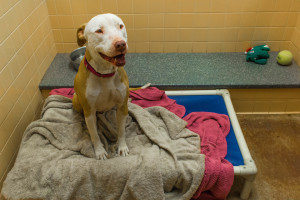
Lenny the pit bull enjoys getting visitors. Photo by Marco Rivera
Lenny the pit bull circles around the kennel with his lips stretched wide in a smile. He waddles and drools and crinkles his eyes as Ben Swan, the public information officer for The Santa Fe Animal Shelter and Humane Society, scratches the sweet spot behind his ears. The hall vibrates with yelps, howls and the slapping of wagging tails.

Ben Swan, public information officer, holds up a terrier puppy. Photo by Marco Rivera
Even though the shelter adopts out an average of 50 cats and dogs per week, larger and badly received breeds like Lenny can spend as long as a year
waiting to find a permanent home. “They stay longer because they have special needs,” Swan says. Lenny weighs more than the easily manageable dog and brims with excitement at Swan’s visit. “They need socializing and exercise. We work with every single one.”
Thanks to dedicated volunteers, dogs like Lenny can get the chance to make human connections, an invaluable gift in the quest to find a forever home. The shelter has a multitude of opportunities for students at the Santa Fe University of Art and Design to get involved. While nearby areas such as La Cienega still experience a high volume of abandoned animals, thanks to the Santa Fe Animal Shelter and the efforts of dozens of volunteers, the stray population of Santa Fe has drastically decreased over the last five years.
From treating cases of malnourishment to abuse to contracted Tularemia, a disease carried by local rabbits, the employees and volunteers of the Humane Society keep busy. “Volunteers do just about everything employees do,” Swan says. These responsibilities include but are not limited to dog walking, grooming, preparing treats and taking the animals to community adoption events. Volunteer opportunities are available to anyone who loves animals. The shelter even offers orientations and training sessions so that both volunteers and animals can share a mutual, healthy space.
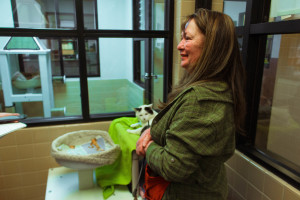
Jeannie Osuna-Mac Isaac grooms Dexter the cat. Photo by Marco Rivera
Jeannie Osuna-Mac Isaac volunteers at least once a week, spending her time at the shelter socializing, grooming, and caring for cats. “I took a year off [of work] and I thought, ‘what can I do with my time that will be good?’” The fifth grade teacher was encouraged by a friend to lend her time to the shelter in August 2015 and has since adopted a cat of her own. “It’s just nice to be able to encourage the cats,” Isaac says. “Some of them come in and they’ve been in bad situations and they don’t trust people yet. It’s nice to be able to do something that helps not only the [animal] but us as people.”
Every week the shelter is packed with volunteers from a variety of backgrounds, including groups from Santa Fe Prep and the MASTERs program. The Santa Fe Animal Shelter also hosts volunteer events for the Santa Fe Community College and SFUAD. “It’s a great time to socialize,” says Devin White, the volunteer coordinator. “It’s also helpful for students to have an outlet. I call it puppy or kitten therapy.”
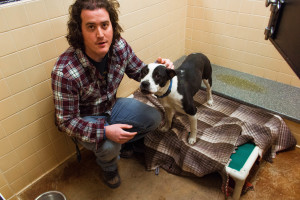
Devin White plays with Sanvean in his kennel. Photo by Marco Rivera
White knows that volunteering is not all fun and games. Forming close bonds with the animals at the shelter can be emotionally taxing. “There are
scenarios that can be problematic,” White says. “[You] get worried about what’s going to happen with the animals. Euthanasia is always a touchy subject.” Despite the emotional weight of working with animals that have undetermined futures, it is only with the help of volunteers that these animals stand a chance at all. With proper behavior training and healthcare, almost every animal can become adoptable.
The Santa Fe Animal Shelter is ever expanding. A clinic and animal hospital are located on site, allowing the shelter to offer their wards the greatest care that can be afforded, and to even intake animals from sister shelters, such as ones in California, for medical treatment. Thanks to a variety of sponsors, the shelter is also able to develop all new spaces including, the Roddy Burdine Rehabilitation Center.
While cases of neglect and abuse are not common in Santa Fe, the occasional dog with severe behavioral issues will make its way into the doors of the shelter. “Sometimes these dogs just need a break,” Swan says. “They need a place where they can really be themselves.” The Roddy Burdine Rehabilitation Center is a facility set about an acre away from the adoption kennels. Just past the entrance is a large recreational area that, from the padded flooring to the minimal acoustics, was designed with dogs in mind. The area is surrounded by doors sporting a variety of hand-written names.

Boo Boo’s life was saved by the Santa Fe Animal Shelter and Humane Society. Photo by Marco Rivera
Boo Boo, a large mixed breed dog resembling a small bear, welcomes Swan into his kennel. He is quiet, unlike the other dogs shielded by the doors that bark nonstop. Swan takes Boo Boo’s head into his hands and nuzzles him. “Boo Boo was left outside without food or water, and only had a trampoline for shelter,” Swan explains. “And when he escaped the yard, he got hit by a car.” While his owners face criminal charges, Boo Boo is calm in his pen that has been furnished like a living room. After a few shorts months, he already seems peaceful. “Volunteers like to spend time with traumatized dogs,” Swan says. “We have a woman who is blind that comes in just to sit with them.” While the accident left Boo Boo with fractures on his front legs, he has a lot more to heal before he’s ready to become someone’s pet.
The rehabilitation center opened in May 2015, and has since increased the number of successfully rehabilitated dogs to 90 percent. “What we do here is unique,” says Emily Burlingame, an employee of the rehab center. “We can house [extreme] behavioral cases without costing the shelter space. [These dogs] would have never received the help they needed before.”
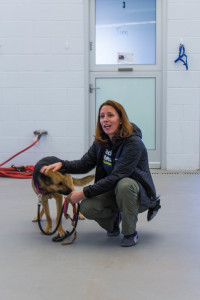
Hannah Padilla calms Tammy down with the collar and leash she was brought in carrying. Photo by Marco Rivera
Tammy, a German Shephard, came to the shelter holding a leash and collar in her mouth. She was very frightened, and she lunged at the volunteers that tried to help her. Tammy’s barking, snapping and overall extreme behavior made her ineligible for adoption. Thanks to the rehab center, Tammy is treated with love and delicacy in her recovery. “We’ve been able to work with her,” says Hannah Padilla, the director of the rehab program. “We make progress so we don’t have to make the euthanasia call.” It took three weeks for staff at the shelter to touch Tammy, and even so, she is skittish. The collar and leash that she arrived with stay by her side. Padilla, with a slow hand, lets Tammy take the leash and collar. Holding them calms her.
Judy Gertz, a volunteer of eight months, says, “The hardest part is going home and leaving the animals here.” A neighbor introduced Gertz to volunteering and she now walks dogs, does nose training, and socializes puppies. “It’s all about helping them get adopted. That is the goal.”
It is thanks to human interaction that the shelter can monitor a dog’s behavior and determine areas that need improvement. Without socialization, matching animals to a suitable home would be impossible. Many of the employees at the Santa Fe Animal Shelter began as volunteers. Working with the animals provides opportunities for anyone to make a difference every day of the year. For more information on how to get involved in volunteer work, visit the shelter’s website or call (505) 983-4309.






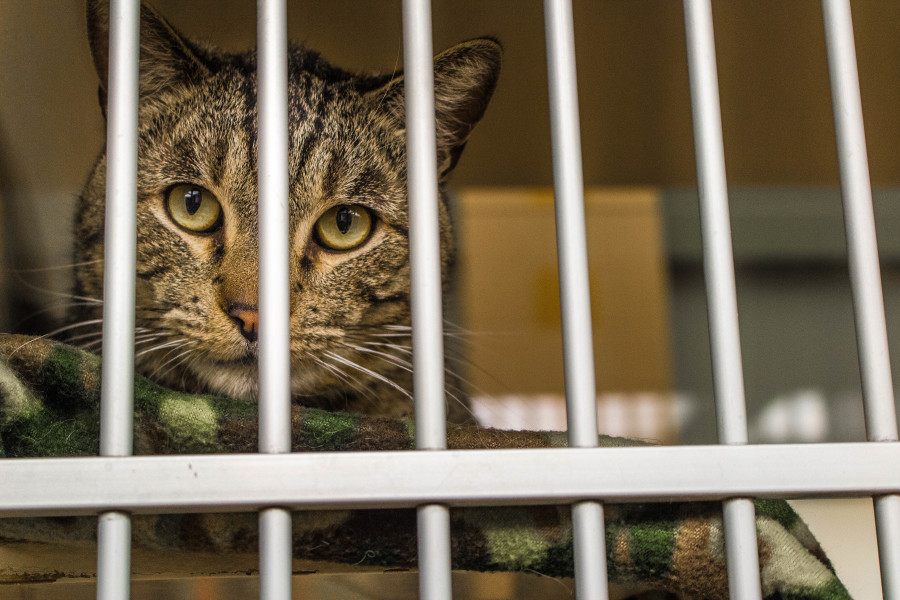

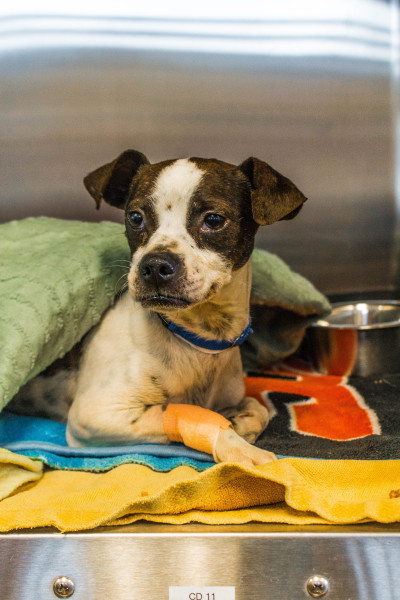
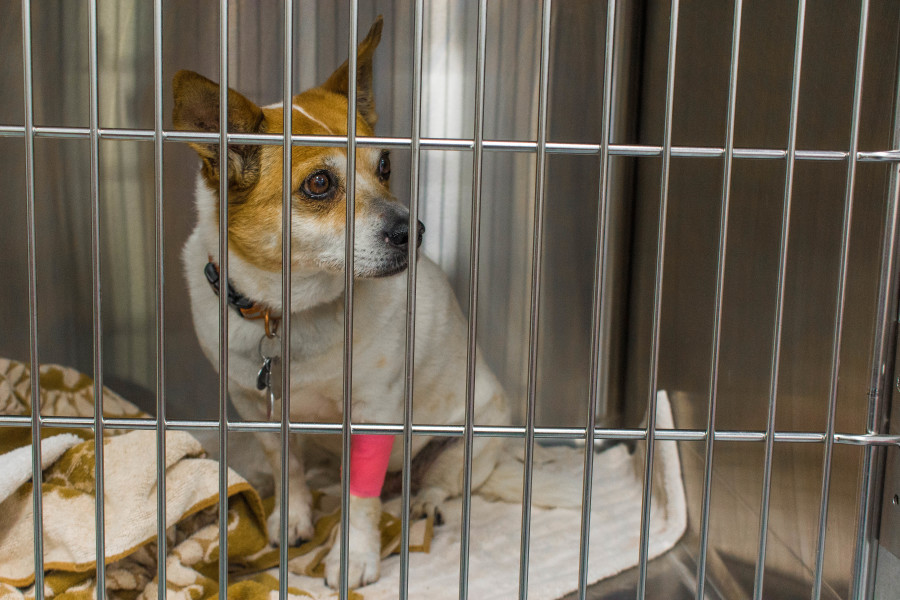
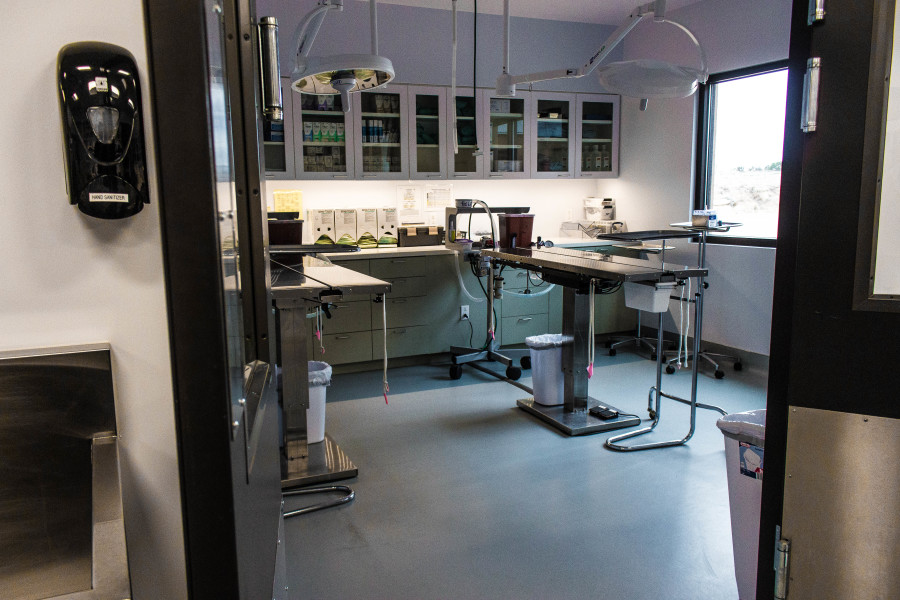
 Jackalope Magazine is the student magazine of Santa Fe University of Art and Design. Building on the interdisciplinary nature of our education, we aim to showcase the talent of our university and character of our city.
Jackalope Magazine is the student magazine of Santa Fe University of Art and Design. Building on the interdisciplinary nature of our education, we aim to showcase the talent of our university and character of our city.
Recent Comments